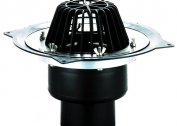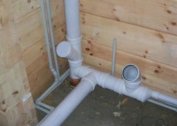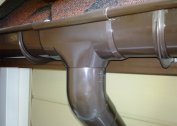Autonomous sewage is installed on a summer cottage or in the territory of a private household for the disposal of wastewater. Complex sewer systems are often built to service several houses or small private companies located outside the city limits. Such systems typically include a sewage treatment plant and a network of pipes leading from the building to the tank.
What design in which case to choose
 The choice of the type of autonomous sewage is based on the needs of the owners, the composition of the soil on the site and the size of material capabilities.
The choice of the type of autonomous sewage is based on the needs of the owners, the composition of the soil on the site and the size of material capabilities.
Basically, the selection of a suitable design is carried out according to the following criteria:
- Septic tank - suitable for a family of 3-5 people living in a private house year-round. The best design functionality is achieved when installed on sandy, sandy loamy soils and chernozem with low groundwater table.
- Dry closet is an excellent choice for long trips by car and short rest in the country. Among these designs, there are both cheap and expensive options equipped with a fill indicator and a toilet paper reservoir.
- Cesspool - suitable for private houses with temporary residence. With year-round use, savings on designs will not be justified, since due to the small capacity it will often be necessary to order a service of aspiration, which in the end will cost more than a septic tank.
- Autonomous station - the most modern and efficient sewage system for houses with permanent residence, which does not require regular maintenance and does not pollute the environment. However, due to the high cost, not everyone can buy it.
Septic tank
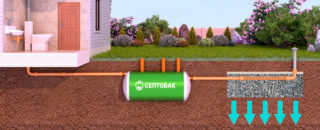 Septic installations are of the following types:
Septic installations are of the following types:
With filter well
With this arrangement, sewage flows through pipes from the house into a well with a sealed bottom. In it, the solid fractions settle, and the fats float and flow into the next well. There may be several such sedimentation tanks - the more, the cleaner the outlet water. At the bottom of the last tank, a pillow is made of gravel and sand, through which water seeps into the soil.
Pros:
- rare service;
- simplicity of construction;
- reasonable cost.
Minuses:
- not suitable for clay soil and high groundwater;
- insufficient degree of purification;
- after 5 years, the last tank will have to be cleaned of silt.
With filtering field
 The design of such a septic tank is similar to the previous one - waste water flows from the well to the well, partially being purified. The main difference is that instead of the usual reservoir with a pillow of crushed stone and sand, a well is equipped, from which pipes with holes, called “filtration fields”, leave. Through them, fluid seeps and is absorbed in the fields.
The design of such a septic tank is similar to the previous one - waste water flows from the well to the well, partially being purified. The main difference is that instead of the usual reservoir with a pillow of crushed stone and sand, a well is equipped, from which pipes with holes, called “filtration fields”, leave. Through them, fluid seeps and is absorbed in the fields.
The pluses are excellent performance and a rare need for maintenance.
Minuses:
- high initial cost;
- need a large area for installation;
- need for replacement after 10 years due to siltation of pipes;
- low level of final water treatment.
With infiltrator and intermediate well
Water flows into the septic tank, flows through the tanks and enters an intermediate well equipped with a drainage pump with a float. It pumps liquid into the infiltrator, preventing sewage from returning to the septic tank. This is especially important in high groundwater.
There are systems without an intermediate well, then the water immediately flows into the infiltrator and leaves through crushed stone and sand.
Pros:
- simple device;
- large area is not required;
- suitable for a site with high groundwater, except for a septic tank without an intermediate well;
- rare need for maintenance.
Minuses:
- volatility;
- low level of cleaning;
- the soil above the infiltrator is not suitable for growing food.
Dry closet
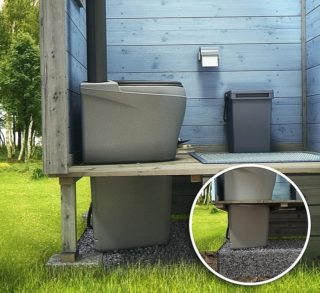 Dry closets are of the following types:
Dry closets are of the following types:
- Chemical.
Special water with flavorings is poured into the upper tank, and a chemical solution is into the lower one. Before using such a toilet and after, you need to drain a little water from the upper tank by pressing the pump or piston on the side. In the lower tank, the waste will be processed using a chemical solution into a relatively safe liquid without an unpleasant odor.
The main minus - you can not pour such a liquid into a compost pit or under plants.
However, instead of chemicals, you can fill in more expensive, but safe solutions with bacteria, which also decompose the waste well, and the liquid after processing is suitable for the garden.
- Peat - "dry."
Instead of water, peat is poured into the upper tank. This is an inexpensive natural filler, 1 kg of which is able to absorb up to 10 liters of liquid.
After using the toilet, you need to turn the knob and fill the waste with peat. It absorbs everything, eliminates odors, and in the second tank, compost will gradually be prepared from sewage and peat mixture. The tank holds up to 140 kg of processing.
This dry closet can be installed in the house so that the seat is in the room, and the second tank is on the street. From there, ready-made compost can be removed immediately with a shovel, without waiting for overflow.
- Electric.
This is a modern toilet, the convenience is not inferior to the usual. It is equipped with a top tank with a button, which is filled with water. After use, you can rinse off in the usual way.
When it enters the lower tank, the waste is cremated under high temperature, and the liquid is discharged through the drain to the site. The resulting ash can be used as top dressing.
However, there are drawbacks - you need a constant connection to electricity, and the cost of the toilet reaches 1 thousand dollars.
Cesspool
 This is the simplest design, consisting of a sealed tank and pipes coming from the building. The pipeline main should be located below the level of soil freezing, and additional warming is recommended.
This is the simplest design, consisting of a sealed tank and pipes coming from the building. The pipeline main should be located below the level of soil freezing, and additional warming is recommended.
A cesspool is made of:
- plastic container - it is durable, resistant to constant humidity, and the weight allows it to be mounted on their own for 3-4 men;
- reinforced concrete ring - because of the enormous mass it is impossible to install without heavy equipment;
- brickwork - only ceramic material is suitable, and the masonry should be carried out in a circle, forming a ring;
- monolithic concrete structure - the formwork is built, and then the cement mixture is poured.
Pros:
- simplicity of construction;
- low cost;
- tightness, groundwater conservation from pollution.
Minuses:
- it is necessary to call the wastewater trucks often because of the quick filling of the pit;
- not suitable for high groundwater;
- bad smell.
Autonomous stations
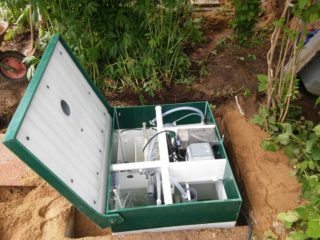 This is a modern sewage system, which at the outlet gives 98% purified water to the ground. It consists of several chambers and mechanical filters. In the biological chamber, bacteria recycle waste, in a mechanical chamber they are cleaned of different fractions. Also there are additional filters at the inlet and outlet.
This is a modern sewage system, which at the outlet gives 98% purified water to the ground. It consists of several chambers and mechanical filters. In the biological chamber, bacteria recycle waste, in a mechanical chamber they are cleaned of different fractions. Also there are additional filters at the inlet and outlet.
Pros:
- water can be drained directly into a reservoir or used for irrigation;
- only mechanical filters require care;
- long-term service - up to 50 years.
Minuses:
- volatility;
- high cost of installation;
- need a lot of space on the site.
Prevention and prevention of problems and errors during operation
To prevent problems and errors during operation, it is necessary to provide:
- The correct slope of the pipes is about 45 degrees, excluding sharp turns.
- Diameter - from 110 mm and more, thin 50 mm pipes will quickly become clogged.
- Fat and fecal runoff should not go into one drain pipe, since cold water when flushing the toilet will cool the edible fat, causing it to freeze and settle on the walls.
- Above the hatches of the septic tank, ventilation pipes 50 cm above the ground should be installed.
For prevention, you need to regularly:
- clean pipes with chemicals to prevent blockages;
- clean them in a hydrodynamic way;
- pump out the grease traps, if any.
Choosing the type of autonomous sewage is no less a serious issue than buying a roof covering or planning a foundation. The convenience of living in the house and the economic feasibility of investments depend on this.
